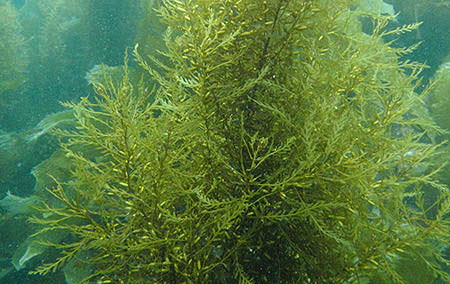Invasive Species
Channel Islands

Why is it a concern?
CINMS is near a major metropolitan area, adjacent to commercial shipping lanes, and is frequented by commercial and recreational boaters, making it vulnerable to introduced marine invasive species. Invasive species have the potential to degrade habitat, outcompete native species, and disrupt ecosystem processes. Protection of sanctuary resources requires the sanctuary to be vigilant for invasive species so that they can be discovered when present, monitored, and studied so informed management decisions regarding control and mitigation can be made. The CINMS needs a plan to address invasive species in general, and has information needs for a recent arrival in particular. Specifically, Sargassum horneri, a non-native alga, was discovered in the Sanctuary in fall 2009, and there are multiple information needs to guide appropriate management responses. In addition, the brown alga Undaria pinnatifida is currently found in mainland harbors and is a potential colonizer in the sanctuary.
Although invasive species do not appear to be much of an issue at present, there are several algal species (including Undaria pinnatifida andCaulacanthus ustulatus) that are appearing in Southern California and have proliferated at Santa Catalina Island and other areas (Miller et al. 2006). Sargassum horneri is present along the mainland from Baja California to Santa Barbara, and at three of the five Channel Islands (Anacapa, Santa Cruz and Santa Barbara) (Marks et al. 2015). The Japanese brown alga Undaria pinnatifida has been found in Santa Barbara and Ventura Harbors and the brown alga Sargassum horneri has been found at Santa Catalina Island. The Asian red alga Caulacanthus ustulatus has been observed at one site at Anacapa Island. If these species become established and widespread at the islands, they could outcompete native species and adversely affect species richness and diversity patterns in the invaded habitats. There are several ongoing monitoring programs that record observations of invasive species as part of their standard procedures, so the sanctuary is hopeful that early detection can be achieved.
Overview of Research
The Channel Islands National Marine Sanctuary is actively seeking research partners to conduct work connected to Invasive Species as a sentinel issue.
| Project Name | PI and contacts | Links |
|---|---|---|
Invasive Species Tracking |
http://gordon.science.oregonstate.edu/marineinvasive/map.html http://www.eeb.ucsc.edu/pacificrockyintertidal/data-products/invasive-species/#submit |
|
Multi-Agency Rocky Intertidal Network (MARINe) |
||
REEF Nearshore Fish Assemblage Monitoring |
Reef Environmental Education Foundation |
|
Invasion of Sargassum horneri |
UCSB, Lindsay Marks; NOAA NMFS Southwest Regional Office; California Sea Grant, Carrie Culver |
No URL available. |
Kelp Forest Monitoring |
Channel Island National Park, Dr. David Kushner |
http://science.nature.nps.gov/im/units/medn/monitor/kelpforest.cfm |
PISCO Monitoring and Surveys |
UCSB, UCSC |
Science Needs and Questions
Invasive species in the Channel Islands National Marine Sanctuary (CINMS or Sanctuary) need to be tracked, monitored, and studied so that impacts to resources can be assessed and potential management actions, such as eradication, can be evaluated.
- Questions regarding Sargassum horneri:
- What is the spatial extent and density?
- What is the best way to monitor the spread of species?
- What is the rate of spread?
- What are the habitat requirements or limitations?
- What are the current or potential ecosystem effects?
- What is the likelihood of Undaria pinnatifida arriving at the Sanctuary and what are the habitat requirements and potential effects?
- What are effective ways to receive information and communicate information among various groups (researchers, visitors, public)?
- Recommendations and a plan are needed for an "early warning system" and action plan for future occurrences of invasive species.
Education and Outreach Material
IPM for Boats: Integrated Pest Management for Hull Fouling in Southern California Coastal Marinas
References
Bullard, S.G., G. Lambert, M.R. Carman, J. Byrnes, R.B. Whitlatch, G. Ruiz, R.J. Miller, L. Harris, P.C. Valentine, J.S. Collie, J. Pederson, D.C. McNaught, A.N. Cohen, R.G. Asch, J. Dijkstra and K. Heinonen. 2007. The colonial ascidian Didemnum sp. A: current distribution, basic biology and potential threat to marine communities of the Northeast and West coasts of North America. Journal of Experimental Biology and Ecology 342:99-108.
Byrnes, J. E., P.L. Reynolds and J.L. Stachowicz. 2007. Invasions and extinctions reshape coastal marine food webs. PLoS ONE 2(3): e295. doi:10.1371/journal.pone.0000295.
Cohen A. and J. Carlton. 1998. Accelerating invasion rate in a highly invaded estuary. Science. 279:555-558.
deRivera, C.E., G.M. Ruiz, J. Crooks, K. Wasson, S. Lonhart, P. Fofonoff, B. Steves, S. Rumrill, M.S. Brancato, S. Pegau, D. Bulthuis, R.K. Preisler, C.G. Schoch, C.E. Bowlby, A. DeVogelaere, M. Crawford, S.R. Gittings, A.H. Hines, L. Takata, K. Larson, T. Huber, A.M. Leyman, E. Collinetti, T. Pascot, S. Shull, M. Anderson and S. Powell. 2005. Broad-scale non-indigenous species monitoring along the west coast in national marine sanctuaries and national estuarine research reserves. Report to National Fish & Wildlife Foundation. Smithsonian Institute, National Estuarine Research Reserve System, National Marine Sanctuary Program, Washington, D.C. 125 pp.
Lockwood, J.L., M.F. Hoopes, M.P. Marchetti. 2007. Invasion Ecology. Blackwell Publishing, Malden, MA.
Maloney E., R. Fairey, A. Lyman, K. Reynolds, M. Sigala. 2006. Introduced aquatic species in California open coastal waters. Final Report. California Department of Fish and Game. Office of Spill Prevention and Response. Sacramento, CA., 93 pp.
Marks, L.M., P. Salinas-Ruiz, D.C. Reed, S.J. Holbrook, C.S. Culver, J.M. Engle, D.J. Kushner, J.E. Caselle, J. Freiwald, J.P. Williams, J.R. Smith, L.E. Aguilar-Rosas, N.J. Kaplanis. 2015. Range expansion of a non-native, invasive macroalga Sargassum horneri (Turner) C. Agardh, 1820 in the eastern Pacific. BioInvasions Records 4(4)243-248.
Miller, K.A., J.M. Engle, S. Uwai, H. Kawai. 2006. First report of the Asian seaweed Sargassum filicinum Harvey (Fucales) in California, USA. Biological Invasions 9(5)609-613.
Sax, D.F., J.J. Stachowicz, S.D. Gaines. 2005. Species invasions: Insight into ecology, evolution, and biogeography. Sinauer Associates, Inc. Sunderland, MA.

